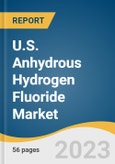Chapter 1. Methodology and Scope
1.1. Market Segmentation & Scope
1.1.1. Application
1.1.2. Regional scope
1.1.3. Estimates and forecast timeline
1.2. Research Methodology
1.3. Information Procurement
1.3.1. Purchased database
1.3.2. Internal database
1.3.3. Secondary sources
1.3.4. Primary research
1.3.5. Details of primary research
1.4. Information or Data Analysis
1.5. Market Formulation & Validation
1.6. Model Details
1.7. List of Secondary Sources
1.8. List of Primary Sources
1.9. Objectives
Chapter 2. Executive Summary
2.1. Market Outlook
2.2. Segment Outlook
2.2.1. Application outlook
2.2.2. Regional outlook
2.3. Competitive Insights
Chapter 3. U.S. Anhydrous Hydrogen Fluoride Market Variables, Trends & Scope
3.1. Market Lineage Outlook
3.2. Penetration & Growth Prospect Mapping
3.3. Value Chain Analysis
3.4. Regulatory Framework
3.5. Market Dynamics
3.5.1. Market driver analysis
3.5.2. Market restraint analysis
3.5.3. Industry opportunities & challenges
3.6. U.S. Anhydrous Hydrogen Fluoride Market Analysis Tools
3.6.1. Industry Analysis - Porter’s
3.6.1.1. Supplier power
3.6.1.2. Buyer power
3.6.1.3. Substitution threat
3.6.1.4. Threat of new entrant
3.6.1.5. Competitive rivalry
3.6.2. PESTEL Analysis
3.6.2.1. Political landscape
3.6.2.2. Technological landscape
3.6.2.3. Economic landscape
3.6.2.4. Social landscape
3.6.2.5. Environmental landscape
3.6.2.6. Legal landscape
Chapter 4. Supplier Portfolio Analysis
4.1. List of Suppliers
4.2. Kraljic Matrix
4.3. Sourcing Best Practices
4.4. Negotiation Strategies
Chapter 5. U.S. Anhydrous Hydrogen Fluoride: Application Estimates & Trend Analysis
5.1. U.S. Anhydrous Hydrogen Fluoride Market: Key Takeaways
5.2. U.S. Anhydrous Hydrogen Fluoride Market: Movement & Market Share Analysis, 2022 & 2030
5.3. Fluoropolymers
5.3.1. Fluoropolymers market estimates and forecasts, 2018 to 2030 (USD Million, Kilo Tons)
5.4. Fluorogases
5.4.1. Fluorogases market estimates and forecasts, 2018 to 2030 (USD Million, Kilo Tons)
5.5. Pesticides
5.5.1. Pesticides market estimates and forecasts, 2018 to 2030 (USD Million, Kilo Tons)
5.6. Others
5.6.1. Others market estimates and forecasts, 2018 to 2030 (USD Million, Kilo Tons)
Chapter 6. U.S. Anhydrous Hydrogen Fluoride Market: Regional Estimates & Trend Analysis
6.1. Regional Outlook
6.2. U.S. Anhydrous Hydrogen Fluoride Market by Region: Key Takeaway
6.3. U.S.
6.3.1. Market estimates and forecasts, 2018 - 2030 (Revenue, USD Million, Volume, Kilo Tons)
6.3.2. Northeast
6.3.2.1. Market estimates and forecasts, 2018 - 2030 (Revenue, USD Million, Volume, Kilo Tons)
6.3.3. Southwest
6.3.3.1. Market estimates and forecasts, 2018 - 2030 (Revenue, USD Million, Volume, Kilo Tons)
6.3.4. West
6.3.4.1. Market estimates and forecasts, 2018 - 2030 (Revenue, USD Million, Volume, Kilo Tons)
6.3.5. Southeast
6.3.5.1. Market estimates and forecasts, 2018 - 2030 (Revenue, USD Million, Volume, Kilo Tons)
6.3.6. Midwest
6.3.6.1. Market estimates and forecasts, 2018 - 2030 (Revenue, USD Million, Volume, Kilo Tons)
Chapter 7. Competitive Landscape
7.1. Recent Developments & Impact Analysis, By Key Market Participants
7.2. Market Participant Categorization
7.2.1. Honeywell International Inc.
7.2.1.1. Company overview
7.2.1.2. Financial performance
7.2.1.3. Product benchmarking
7.2.1.4. Strategic initiatives
7.2.2. Solvay
7.2.2.1. Company overview
7.2.2.2. Financial performance
7.2.2.3. Product benchmarking
7.2.2.4. Strategic initiatives
7.2.3. Linde plc
7.2.3.1. Company overview
7.2.3.2. Financial performance
7.2.3.3. Product benchmarking
7.2.3.4. Strategic initiatives
7.2.4. Arkema
7.2.4.1. Company overview
7.2.4.2. Financial performance
7.2.4.3. Product benchmarking
7.2.4.4. Strategic initiatives
7.2.5. LANXESS
7.2.5.1. Company overview
7.2.5.2. Financial performance
7.2.5.3. Product benchmarking
7.2.5.4. Strategic initiatives
List of Tables
Table 1 List of abbreviation
Table 2 U.S. anhydrous hydrogen fluoride market, by application, 2018 - 2030 (USD Million, Kilo Tons)
Table 3 U.S. anhydrous hydrogen fluoride market, by region, 2018 - 2030 (USD Million, Kilo Tons)
Table 4 Northeast anhydrous hydrogen fluoride market, by application, 2018 - 2030 (USD Million, Kilo Tons)
Table 5 Southwest anhydrous hydrogen fluoride market, by application, 2018 - 2030 (USD Million, Kilo Tons)
Table 6 West anhydrous hydrogen fluoride market, by application, 2018 - 2030 (USD Million, Kilo Tons)
Table 7 Southeast anhydrous hydrogen fluoride market, by application, 2018 - 2030 (USD Million, Kilo Tons)
Table 8 Midwest anhydrous hydrogen fluoride market, by application, 2018 - 2030 (USD Million, Kilo Tons)
List of Figures
Fig. 1 Market research process
Fig. 2 Data triangulation techniques
Fig. 3 Primary research pattern
Fig. 4 Market research approaches
Fig. 5 Value-chain-based sizing & forecasting
Fig. 6 QFD modeling for market share assessment
Fig. 7 Market formulation & validation
Fig. 8 U.S. anhydrous hydrogen fluoride: Market outlook
Fig. 9 U.S. anhydrous hydrogen fluoride: Competitive insights
Fig. 10 Parent market outlook
Fig. 11 Related/ancillary market outlook
Fig. 12 Penetration and growth prospect mapping
Fig. 13 Industry value chain analysis
Fig. 14 U.S. anhydrous hydrogen fluoride market driver impact
Fig. 15 U.S. anhydrous hydrogen fluoride market restraint impact
Fig. 16 U.S. anhydrous hydrogen fluoride market strategic initiatives analysis
Fig. 17 U.S. anhydrous hydrogen fluoride market: Application movement analysis
Fig. 18 U.S. anhydrous hydrogen fluoride market: Application outlook and key takeaways
Fig. 19 Fluoropolymers market estimates and forecasts, 2018 - 2030
Fig. 20 Fluorogases market estimates and forecasts, 2018 - 2030
Fig. 21 Pesticides market estimates and forecasts, 2018 - 2030
Fig. 22 Others market estimates and forecasts, 2018 - 2030
Fig. 23 U.S. anhydrous hydrogen fluoride market: Regional movement analysis
Fig. 24 U.S. anhydrous hydrogen fluoride market: Regional outlook and key takeaways
Fig. 25 Northeast market estimates and forecasts, 2018 - 2030
Fig. 26 Southwest market estimates and forecasts, 2018 - 2030
Fig. 27 West market estimates and forecasts, 2018 - 2030
Fig. 28 Southeast market estimates and forecasts, 2018 - 2030
Fig. 29 Midwest market estimates and forecasts, 2018 - 2030









